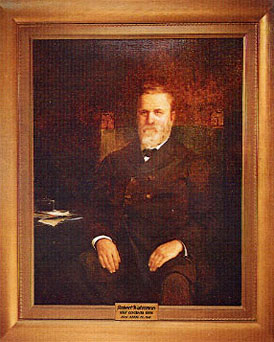Robert Whitney Waterman was born in Fairfield, New York, on December 15, 1826 and migrated with his family to Illinois. He received a rudimentary education in Sycamore, Illinois. In 1850 Waterman decided to trek overland to California. He mined for gold before opening a store near the Feather and Yuba Rivers. The following year, he returned to Illinois, becoming a prosperous storekeeper and newspaper owner whose enthusiasm for politics led him to join the young Republican Party of Illinois. He and his family returned to California in 1873, established a ranch near San Bernardino, and undertook various business enterprises. The most successful by far was the acquisition and development of seventeen silver mining claims.
Waterman helped form the Illinois Republican party in 1854, and in 1856 he was one of two Illinois delegates to the first Republican National Convention in Bloomington, Illinois; the other was Abraham Lincoln. Waterman played a key role in delivering Illinois to Abraham Lincoln’s presidential race in 1860.
In California, Waterman remained active in the Republican Party. His involvement led to his nomination as lieutenant governor in 1886. Once elected, he succeeded to the governor’s office in September 1887 when Governor Washington Bartlett died. During Waterman’s tenure, one major issue was whether the state of California should be divided into two states. Waterman vowed to run the state like a business and not tolerate dishonesty, drunkenness or excessive spending. He harangued the legislature for having 228 clerks at a time when they were only entitled to 35.
Waterman left office on January 8, 1891, retiring from public service, and returning to his various business investments. In poor health towards the end of his term, Governor Robert Waterman died five months after leaving office on April 12, 1891. His papers and photographs are in The Bancroft Library at UC Berkeley and the San Diego Historical Society.















































 Biography
Biography